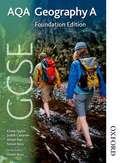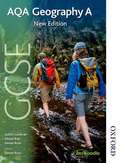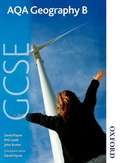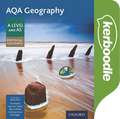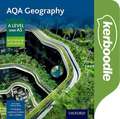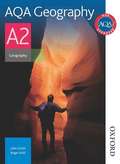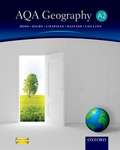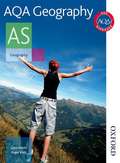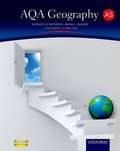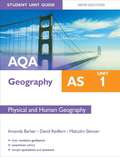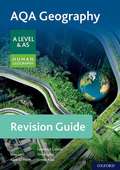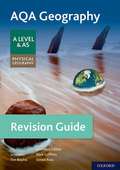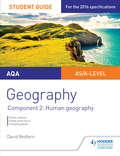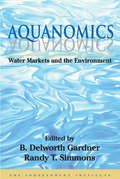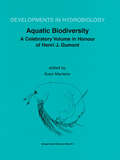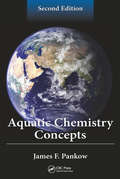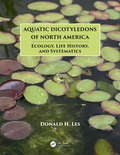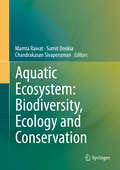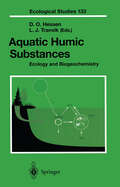- Table View
- List View
AQA GCSE Chemistry 9-1 For Combined Science Grade 5 Booster Workbook (GCSE Science 9-1)
by Dorothy Warren Gemma YoungAQA GCSE Geography A: Foundation Edition (PDF)
by Simon Ross Judith Canavan Kirsty Taylor Alison RaeThe AQA GCSE Geography A Foundation Edition student book has been updated to support the revised specification and provides accessible foundation tier support to help students targeting a grade C, including foundation tier practice questions. Includes contemporary case studies such as the Tohoku tsunami, the EyjafjallajOkull volcanic eruption and the Cockermouth floods, and can be used alongside the New Edition student book in mixed-ability classes.
AQA GCSE Geography A, New Edition (PDF)
by Simon Ross Judith Canavan Alison RaeThe new edition of this student book has been updated to support the exams from June 2014. It includes up-to-date case studies including the Tohoku tsunami, the Eyjafjallajokull volcanic eruption, and the Cockermouth floods, and is now more accessible for your students, without compromising specification coverage.
AQA GCSE Geography B: Student Book (PDF)
by Payne David Bartlett Keith Lamb Philip Rutter JohnAQA GCSE Geography B is the only resource to have been developed with and exclusively endorsed by AQA for the new 2009 specification. With a real focus on tracking individual progress, you can improve your students' chance of exam success through a unique blend of print and online resources.
AQA GCSE Physics 9-1 For Combined Science Grade 5 Booster Workbook (GCSE Science 9-1 Series)
by Stephanie Grant Lynn PharaohAQA Geography A Level & AS: Physical Geography Kerboodle Resources and Assessment (PDF)
by Simon Ross Alice GriffithsDeveloped specially for the 2016 AQA AS and A Level Geography specifications, with dedicated Student Books for physical and human geography and a wealth of support on Kerboodle, these clear and student-friendly resources cover the required content in the necessary depth and detail. Coverage of the new AS and A Level specifications. The Student Books for this course have been approved by AQA Answer guidance for the Student Book activities, digital Student Books and Teacher Handbooks, and lots of assessment support all on Kerboodle From a team of skilled authors, led by Simon Ross and Alice Griffiths
AQA Geography A Level & AS: Human Geography Kerboodle Resources and Assessment (PDF)
by Simon Ross Alice GriffithsDeveloped specially for the 2016 AQA AS and A Level Geography specifications, with dedicated Student Books for physical and human geography and a wealth of support on Kerboodle, these clear and student-friendly resources cover the required content in the necessary depth and detail. Coverage of the new AS and A Level specifications. The Student Books for this course have been approved by AQA Answer guidance for the Student Book activities, digital Student Books and Teacher Handbooks, and lots of assessment support all on Kerboodle From a team of skilled authors, led by Simon Ross and Alice Griffiths
AQA Geography A2: Student Book (PDF)
by Smith John Knill RogerAQA Geography is the only set of resources to have been developed with, and exclusively endorsed by AQA, making them the first choice to support AQA's 2008/2009 specification for AS and A2.
AQA Geography A2 (PDF) (400MB+)
by Simon Ross Bob Digby Tim Bayliss Lawrence Collins Russell Chapman400MB+ File Request - email bookshare@rnib.org.uk to request this title by WeTransfer. This is a student-friendly and engaging resource for AQA GCE A2 specification. Written to match the demands of the specification, this student book motivates your students with accessible, interesting content and up-to-date case studies, while retaining exam-driven rigour.
AQA Geography AS: Student Book (PDF)
by Smith John Knill RogerAQA Geography is the only set of resources to have been developed with, and exclusively endorsed by AQA, making them the first choice to support AQA's 2008/2009 specification for AS and A2.
AQA Geography AS: Student Book (PDF)
by Smith John Knill RogerAQA Geography is the only set of resources to have been developed with, and exclusively endorsed by AQA, making them the first choice to support AQA's 2008/2009 specification for AS and A2.
AQA Geography AS (PDF)
by Simon Ross Bob Digby Russell Chapman Dan CowlingThis is a student-friendly and engaging resource for AQA GCE AS specification. Written to match the demands of the specification, this student book motivates your students with accessible, interesting content and up-to-date case studies, while retaining exam-driven rigour.
AQA Geography AS Student Unit Guide: Physical and Human Geography (student unit guide) (PDF)
by Amanda Barker David Redfern Malcolm SkinnerPerfect for revision, this guide explains the unit requirements, summarises the content and includes specimen questions with graded answers. Feel confident you understand the unit: this guide comprehensively covers the unit content and includes topic summaries, knowledge check questions and a reference index. Get to grips with the exam requirements: the specific skills on which you will be tested are explored and explained. Analyse exam-style questions: graded student responses will help you focus on areas where you can improve your exam technique and performance.
AQA Geography for A Level & AS Human Geography Revision Guide
by Alice Griffiths Tim Bayliss Lawrence Collins Simon RossComplements the most student-friendly and engaging course for the 2016 AQA A Level and AS Level Geography specifications. Written to present the key points of each AQA Geography for A Level & AS Human Geography Student Book section in a clear and accessible visual style to aid knowledge retention.
AQA Geography for A Level & AS Physical Geography Revision Guide
by Tim Bayliss Alice Griffiths Lawrence Collins Simon RossComplements the most student-friendly and engaging course for the 2016 AQA A Level and AS Level Geography specifications. Written to present the key points of each student book section in a clear and accessible visual style to aid knowledge retention.
AQA Geography Student Guide: Human Geography (PDF)
by David RedfernExam Board: AQALevel: AS/A-levelSubject: GeographyFirst Teaching: September 2016First Exam: September 2017Reinforce students' geographical understanding throughout their course; clear topic summaries with sample questions and answers help students improve their exam technique and achieve their best.Written by a teacher with extensive examining experience, this guide:- Helps students identify what they need to know with a concise summary of the topics examined at AS and A-level- Consolidates understanding through assessment tips and knowledge-check questions- Offers opportunities for students to improve their exam technique by consulting sample graded answers to exam-style questions- Develops independent learning and research skills- Provides the content students need to produce their own revision notes
Aquanomics: Water Markets and the Environment
by B. Delworth Gardner Randy T. SimmonsWater is becoming increasingly scarce. If recent usage trends continue, shortages are inevitable. Aquanomics discusses some of the instruments and policies that may be implemented to postpone, or even avoid, the onset of water crises. These policies include establishing secure and transferable private water rights and extending these rights to uses that traditionally have not been allowed, including altering in-stream flows and ecosystem functions. The editors argue that such policies will help maximize water quantity and quality as water becomes scarcer and more valuable. Aquanomics contains many examples of how this is being accomplished, particularly in the formation of water markets and market-like exchanges of water rights.Many observers see calamity ahead unless water supplies are harnessed and effectively conserved, and unless water quality can be improved. It is also clear that declining water quality is a serious problem in much of the world, as increasing human activities induce high levels of water degradation. Those who voice these concerns, argue the contributors to this volume, fail to consider the forces for improvement inherent in market political-economic systems that can address water issues. The contributors see water quality in economically advanced countries as improving, and they believe this establishes the validity of market-based approaches.
Aquanomics: Water Markets and the Environment
by Randy SimmonsWater is becoming increasingly scarce. If recent usage trends continue, shortages are inevitable. Aquanomics discusses some of the instruments and policies that may be implemented to postpone, or even avoid, the onset of water crises. These policies include establishing secure and transferable private water rights and extending these rights to uses that traditionally have not been allowed, including altering in-stream flows and ecosystem functions. The editors argue that such policies will help maximize water quantity and quality as water becomes scarcer and more valuable. Aquanomics contains many examples of how this is being accomplished, particularly in the formation of water markets and market-like exchanges of water rights.Many observers see calamity ahead unless water supplies are harnessed and effectively conserved, and unless water quality can be improved. It is also clear that declining water quality is a serious problem in much of the world, as increasing human activities induce high levels of water degradation. Those who voice these concerns, argue the contributors to this volume, fail to consider the forces for improvement inherent in market political-economic systems that can address water issues. The contributors see water quality in economically advanced countries as improving, and they believe this establishes the validity of market-based approaches.
Aquatic Biodiversity: A Celebratory Volume in Honour of Henri J. Dumont (Developments in Hydrobiology #171)
by Koen MartensIn this age of increased fundamental and applied research on biodiversity, no single volume was as yet devoted to the various temporal and spatial aspects of aquatic biodiversity. The present book is published in honour of Professor Henri Dumont (Ghent, Belgium) at the occasion of his retirement as Editor-in-Chief of Hydrobiologia. The volume presents a selection of contributions on aquatic biodiversity, written by colleagues from the editorial board, fellow editors of aquatic journals and former students and collaborators. Contributions deal with a wide spectrum of topics related to aquatic biodiversity and cover fields such as actual- and palaeolimnology, taxonomy, and fundamental and applied limnology. Even reconnaissance chapters on management and cultural impact of water bodies are included. The book combines state-of-the-art contributions in aquatic sciences.
Aquatic Chemistry Concepts, Second Edition
by James F. PankowAquatic Chemistry Concepts, Second Edition, is a fully revised and updated textbook that fills the need for a comprehensive treatment of aquatic chemistry and covers the many complicated equations and principles of aquatic chemistry. It presents the established science of equilibrium water chemistry using the uniquely recognizable, step-by-step Pankow format, which allows a broad and deep understanding of aquatic chemistry. The text is appropriate for a wide audience, including undergraduate and graduate students, industry professionals, consultants, and regulators. Every professional using water chemistry will want this text within close reach, and students and professionals alike will expect to find at least one copy on their library shelves. Key Features Extremely thorough, one-of-a-kind treatment of aquatic chemistry Discussions of how to carry out complex calculations regarding the chemistry of lakes, rivers, groundwater, and seawater Numerous example problems worked in complete detail Special foreword by Jerry L. Schnoor
Aquatic Chemistry Concepts, Second Edition
by James F. PankowAquatic Chemistry Concepts, Second Edition, is a fully revised and updated textbook that fills the need for a comprehensive treatment of aquatic chemistry and covers the many complicated equations and principles of aquatic chemistry. It presents the established science of equilibrium water chemistry using the uniquely recognizable, step-by-step Pankow format, which allows a broad and deep understanding of aquatic chemistry. The text is appropriate for a wide audience, including undergraduate and graduate students, industry professionals, consultants, and regulators. Every professional using water chemistry will want this text within close reach, and students and professionals alike will expect to find at least one copy on their library shelves. Key Features Extremely thorough, one-of-a-kind treatment of aquatic chemistry Discussions of how to carry out complex calculations regarding the chemistry of lakes, rivers, groundwater, and seawater Numerous example problems worked in complete detail Special foreword by Jerry L. Schnoor
Aquatic Dicotyledons of North America: Ecology, Life History, and Systematics
by Donald H. LesAquatic Dicotyledons of North America: Ecology, Life History, and Systematics brings together a wealth of information on the natural history, ecology, and systematics of North American aquatic plants. Most books on aquatic plants have a taxonomic focus and are intended primarily for identification. Instead, this book provides a comprehensive overview of the biology of major aquatic species by compiling information from numerous sources that lie scattered among the primary literature, herbarium databases, and other reference materials. Included dicotyledon species are those having an obligate (OBL) wetland status, a designation used in the USACE National Wetland Plant List. Recent phylogenetic analyses are incorporated and rationale is provided for interpreting this information with respect to species relationships. This diverse assemblage of information will be useful to a wide range of interests including academic researchers, wildlife managers, students, and virtually anyone interested in the natural history of aquatic and wetland plants. Although focusing specifically on North America, the cosmopolitan distribution of many aquatic plants should make this an attractive text to people working virtually anywhere outside of the region as well. This book is an essential resource for assisting with wetland delineation.
Aquatic Dicotyledons of North America: Ecology, Life History, and Systematics
by Donald H. LesAquatic Dicotyledons of North America: Ecology, Life History, and Systematics brings together a wealth of information on the natural history, ecology, and systematics of North American aquatic plants. Most books on aquatic plants have a taxonomic focus and are intended primarily for identification. Instead, this book provides a comprehensive overview of the biology of major aquatic species by compiling information from numerous sources that lie scattered among the primary literature, herbarium databases, and other reference materials. Included dicotyledon species are those having an obligate (OBL) wetland status, a designation used in the USACE National Wetland Plant List. Recent phylogenetic analyses are incorporated and rationale is provided for interpreting this information with respect to species relationships. This diverse assemblage of information will be useful to a wide range of interests including academic researchers, wildlife managers, students, and virtually anyone interested in the natural history of aquatic and wetland plants. Although focusing specifically on North America, the cosmopolitan distribution of many aquatic plants should make this an attractive text to people working virtually anywhere outside of the region as well. This book is an essential resource for assisting with wetland delineation.
Aquatic Ecosystem: Biodiversity, Ecology And Conservation
by Mamta Rawat Sumit Dookia Chandrakasan SivaperumanThis book brings together the latest information on the rapid advances and developments in the field of aquatic ecology. India is very rich in terms of biological diversity due to its wide range of habitats and climatic conditions. It is home to as much as 7 per cent of the world’s animal species, although it only accounts for about 2 per cent of the total landmass. The present work on biodiversity, ecology and conservation of aquatic resources represents original research in the field of aquatic biodiversity, wetland ecology and its applications with reference to the country’s aquatic resources. There are 19 chapters, each contributed by an expert in his/her particular field and offering novel approaches to various topics in the area of aquatic ecosystems.
Aquatic Humic Substances: Ecology and Biogeochemistry (Ecological Studies #133)
by Dag Hessen Lars J. TranvikHumic substances occur in all kinds of aquatic systems, but are particularly important in northern, coniferous areas. They strongly modify the aquatic ecosystems and also constitute a major problem in the drinking water supply.This volume covers all aspects of aquatic humic substances, from their origin and chemical properties, their effects on light and nutrient regimes and biogeochemical cycling, to their role regarding organisms, productivity and food web organization from bacteria to fish. Special emphasis is paid to carbon cycling and food web organization in humic lakes, but aspects of marine carbon cycling related to humus are treated as well.

